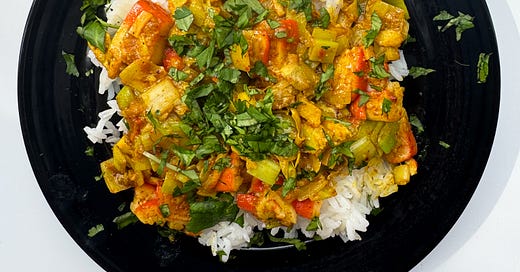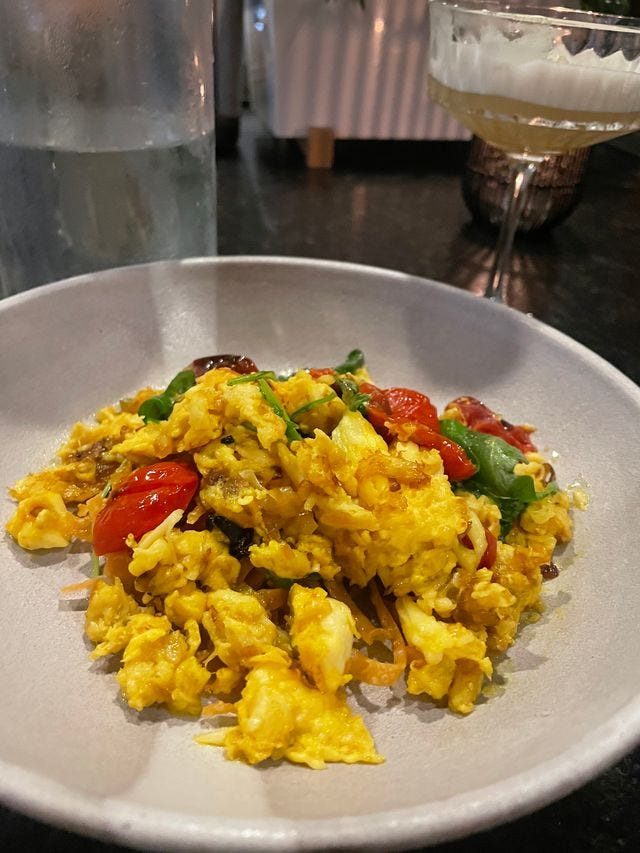Crossroads, No. 9: Nick Bognar's Yellow Curry Crab Stir-Fry
Imitation {crab} is the sincerest form of flattery
Crossroads is a column about cooking and eating at the crossroads of multiple cultures. We explore dishes created from immigrants’ resourcefulness and creativity as they create the foods of their homeland while having to make do with the ingredients they have available to them in their new environment. This isn’t “fusion cuisine” (as in, the kind of stuff that would be served at a restaurant or marketed to the masses), but rather, food that’s part of a quirky, in-between cuisine reflective of where they’re from and where they currently live—something rooted simultaneously in tradition and innovation. You can check out TOD’s archive of past recipes here.
As the son of a professional chef who spent his childhood acutely observing and watching how his mother navigated a kitchen, Nick Bognar had early insight into what a career in food would entail. His mother, Ann Bognar, grew up in Thailand and moved to St. Louis in the late 80s, as many of her siblings were moving stateside and taking jobs in the hospitality industry. She started as a hostess in a Holiday Inn, then eventually worked her way up to their director of food and beverage. She took her first plunge into entrepreneurship in 1998, first by helping her brother open up Manee Thai, one of the first Thai restaurants in the St. Louis Area, and starting her own Japanese restaurant, Nippon Tei, a few years later—which would be the backdrop for much of Nick’s formative years.
“I have a unique perspective through food. Cooking for as long as I have at this point, it just kinda happens,” Nick explains. “There’ll always be some sort of influence on any dish we’re making, whether it’s from something my grandmother passed down to all of us, food I’ve experienced with my family, and [the experience of] working in different restaurants and cooking in general.”
Nippon Tei has since closed its doors, but Nick now manages two restaurants: Sado, another Japanese eatery and sushi bar that he runs with Ann, and indo, which serves dishes that blend Southeast Asian flavors with Japanese cooking techniques. (There, you’ll find Nick’s signature yellowtail sashimi with Thai kosho and coconut nam pla, or his grandmother’s creative take on larb involving lamb tartare tossed in toasted spices and served with sesame crackers).
Ann made the Herculean task of putting dinner on the table each day as a working mother look effortless. She loved working with food regardless, and feeding her family became an opportunity to experiment in the kitchen—creating riffs off familiar flavors she grew up with. A household staple for the Bognars, as Nick recalled, was a dish she often made for him after school reminiscent of pu pad pong karee, Thai stir-fried crab with soft, custardy eggs and yellow curry powder. Ann’s rendition ended up more akin to scrambled eggs. With fresh crab too expensive to obtain, however, she opted for imitation crab sticks—and while you’d normally find Chinese celery in pu pad pong karee for an element of green, she decided to use sliced leeks.
“Being in South County, the closest Asian market was probably in the city,” Nick reminisces. “I have this distinct memory of my mom coming home hungry with her chef coat still on, and taking the imitation crab, yellow curry powder, garlic, butter, eggs, and putting it all together with some rice. I always remember that dish.”
At one point, Nick decided to revamp Ann’s creation into a dish for one of his restaurants, first by making butter steeped with yellow curry to impart richness and distinct flavor to the scrambled egg, and then folding in fresh crab, arugula, and cherry tomatoes before serving it over crispy wontons.
Nothing, of course, tops the way Ann made it—a comforting, nostalgic dish that’s quintessentially all (Thai-)American.
“I think, sometimes, people think of food as ‘not good’ if it’s not authentic. My family never really cooked pure, authentic Thai food. Even my grandmother’s larb. It’s not larb for a lot of people, it’s larb for my family. This [yellow curry crab stir-fry] that my mom used to cook actually is really cool, but it’s not going to be authentic—but it is us. It’s an expression of our life experience and where we’re from, where we move to. That’s what food has become.”
“I’m not going to cook ‘perfect’ Thai food because people think I should. That’s not me as a person. That’s what it’s become for a lot of people, and a lot of really successful chefs across America. I think it’s cool that my life experience has become something people begin to understand in [my] cooking. Back in the day, we’d get beat down because something ‘isn’t authentic’ or what it’s ‘supposed to be.’ But when immigrants come here, some ingredients aren’t accessible to them. There’s something beautiful about the fact that they can improvise, and that helps to create another cuisine in itself. Food doesn’t have to be prescriptive.”






